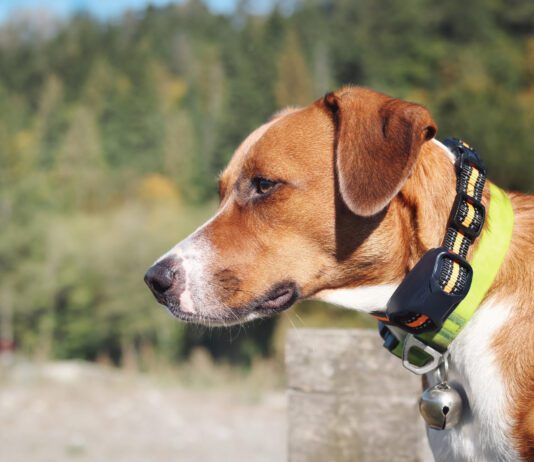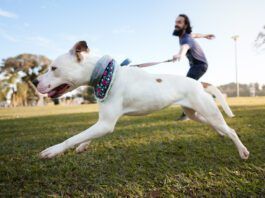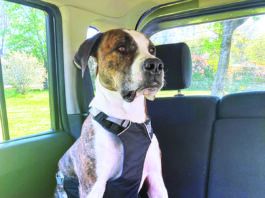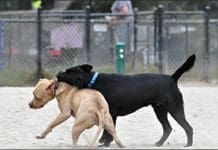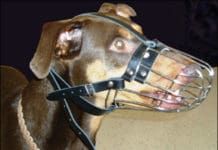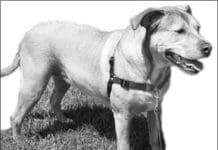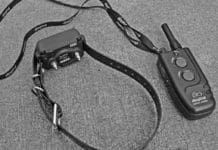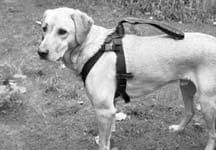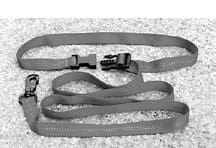The No-Pull Harness Debate
Recently, WDJ received a letter from Christine Zink, DVM, PhD, DACVP, DACVSMR, who was concerned about the photo in WDJ (on the cover, no less!) of a jogger whose dog, running alongside, was wearing a front-clip-type harness. A sports medicine guru and canine athlete enthusiast, Dr. Zink (and others) posit that no-pull harnesses are detrimental to a dog's structure and gait and are especially inappropriate for canine athletes.
When Dog Collars Become Deadly
I was pretty traumatized recently by a phenomenon I had heard about many times but had never before seen: the intense, chaotic, life-or-death struggle that ensues when one dog gets his jaw stuck in another dog's collar. These dogs survived the experience. But since I've been telling my friends about my experience (with all the fervor of the recently converted), I've heard about a number of dogs whose jaws were broken in similar situations
Control Harness Fitting and Use Tips
Here are some trade secrets to getting your control harness to work better for you and your dog. With several of the simpler styles (SENSE-ation, SENSE-ible, Easy Walk) if you can’t get the harness to fit quite right, try putting it on upside down. (Doesn’t work with any of the “two-points-of-contact” harnesses.) If the front strap still slips down, clip your leash to the front-clip ring and the collar ring. This may diminish the effectiveness of the harness a little, but it will keep the front strap up and in place.
No-Pull Dog Harness Product Review
Once upon a time, a harness was the last thing you wanted to use for a dog who pulled, because they were designed to make pulling comfortable. By distributing pressure evenly across the chest they removed pressure from the throat, where damage could be done to a dog's trachea sometimes even to the point of tracheal collapse. Harnesses are better for the dog from a health perspective, but from a training viewpoint, a standard harness actually encourages pulling. There's a reason sled dogs wear harnesses! Head halters were introduced in the late 1990s as a gentle control tool. While they did, indeed, work well to control a dog's head (and where the head goes, the body follows), some trainers noticed that a significant number of dogs found head halters to be fairly aversive, requiring, in many cases, extensive conditioning to convince the dog to accept them.
Training Your Dog to Comfortably Wear a Muzzle
Long thought to be a sign of a bad dog
Leashes, Collars, Harnesses: Best Gear for Positive Training
One bright spring Sunday, my husband and I took a motorcycle trip through Virginia, stopping in the dog-friendly town of Leesburg for lunch. As we ate I watched a steady stream of leashed dogs walk by our restaurant window. Before long I noticed a strange consistency: every single dog was wearing a prong collar. The sun dimmed a little for me, because I cannot imagine a training situation for which I would be willing to use a prong collar - and I certainly wouldn't use one as an everyday dog-walking tool. But the collars appeared to be commonly accepted and used in that community. A roomful of dog trainers will never agree on the best equipment for walking, training, or exercising a dog. If you restrict membership in the room to positive" trainers you'll find more agreement
The Canine Shock Collar Debate
The chasm between those who abhor the electronic/shock collars as an abusive dog training tool and those who support and promote it as an exceptionally effective and humane training tool is so huge it will probably never be bridged. In more moderate positions in the middle of that chasm are those who believe that the collar can be an effective training tool for very limited circumstances in the hands of skilled professionals, and those who prefer not to use them but feel compelled to educate clients who insist on using them on how to use them properly.
A Close Look at Dog Collars
What, exactly, do we like in a collar? To start, we look for top-quality materials – leather that is soft and supple, evenly dyed, neither greasy nor dry; nylon that feels smooth and pliable; and buckles and snaps that open and close easily and securely. Next, we examine the quality of the workmanship. We want to see tight, even stitching, and nylon ends that are smoothly heat-sealed to prevent fraying.
Car Restraints for Dogs
Every day, people load their dogs into cars for trips to the vet or dog park, to run errands, visit friends, or to take day trips. We advocate keeping your dog restrained at all times when he’s traveling with you. The best form of protection is a crate, securely strapped or, better yet, bolted down to keep it from shifting. If your dog’s crate is too big for your car, a doggie seat belt is our recommended alternative.
Proper Identification Tags Can Save Your Dog’s Life
We can never say it often enough or loudly enough – proper identification can save your dog’s life. A dog license is required by law to be worn on your dog’s collar in most places in this country. Owner information from a license can usually be tracked through the local Animal Services agency or Health Department so the lost dog can be returned to his owner if he is picked up by an Animal Services Officer or turned over to an animal shelter by a helpful humanitarian. Obtaining your license in a timely manner can also save you money, since failure to do so can result in citations and fines.
Hands-Free Dog Leashes
With more than 25 years of working with animals professionally under my belt, I don’t find many new product concepts that come as a total and pleasant surprise to me. What a delight, then, to test hands-free leashes for Whole Dog Journal and discover that the best of these products, which started making their appearance in the pet supply retail market in recent years, offer far more than just a convenient way to free up your hands while walking your dog on leash. Few things irritate me more than having a dog constantly tugging on the leash. Thanks to my new doggie daycare center, I now find myself in the position of walking untrained dogs far more frequently than before.
No-Slip Dog Collars
No-slip collars are another special-purpose training tool that can be valuable in certain cases. I use only positive reinforcement training methods, and generally don’t allow the use of choke chains in my training classes. But occasionally a student explains that she uses a choke chain because her dog slips out of a regular collar unless it is tightened to the point of the dog’s discomfort. In the interest of helping people who have found themselves in similar circumstances, I tested three collars designed to prevent dogs from slipping away. However, these collars prohibit unlimited choking, making them much more humane options than standard choke collar.


